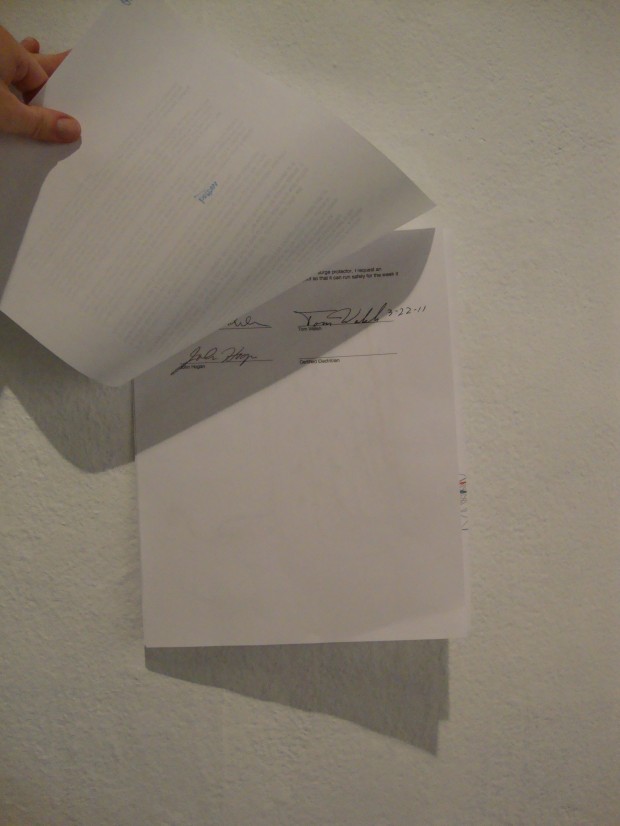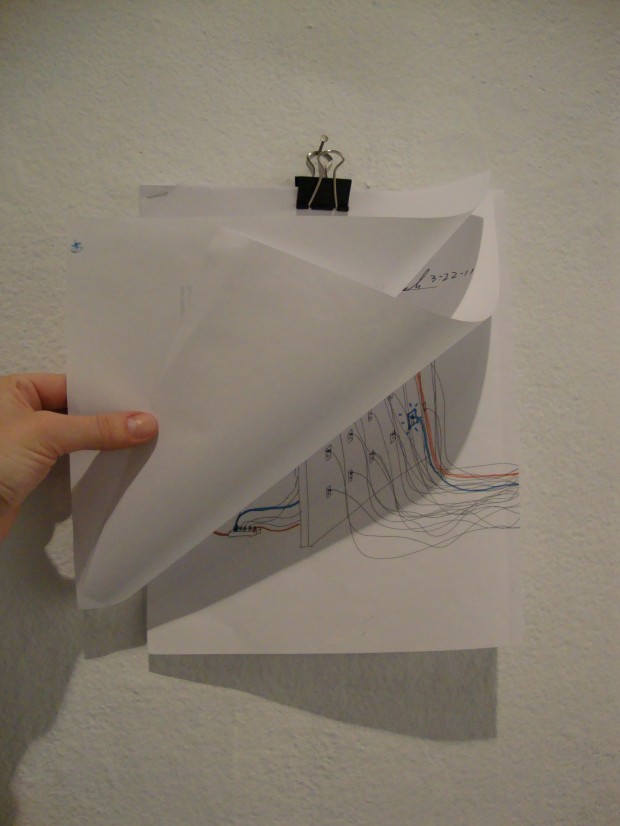Installation in Lime Gallery
April 3 – April 9, 2011
For my MFA thesis exhibition, I propose an installation consisting of black rubberized electrical cord, a heating pad, and a wall of electrical outlets that are arranged in a grid formation – 4 outlets high and 5 outlets across, spaced approx. 2 feet apart. The electricity for the heating pad in the installation will be supplied from one existing outlet in the gallery space located behind the constructed wall. Although there are 20 electrical outlets visible, only one will actually be functional. It is the intention of the piece to construct it in such a way as to convince the viewer that the path of electricity is manipulated and channeled through all the cords, from socket to heating pad. Since it isn’t physically possible to channel electricity through this created path of most resistance, the theoretical idea will be physically faked.
The constructed wall for the 20 electrical outlets, made out of .25” plywood and 2x4s, will measure 10’ high x 12’ wide. This leaves a little less than a foot on either side of the wall so that the viewer can peek behind it, yet is not able to walk around it. The wall will be spaced approx. 3 feet away from the back wall of the Lime Gallery, and is attached on the top via L-brackets to it.
A surge protector will be plugged into the existing outlet located behind the constructed wall. Five electrical cords will be plugged in, seemingly leading to the back of the sockets in the wall. Although five will be seen only one will be working, meaning that only one of the plugs plugged into the surge protector will have the black, white, and ground wire inside the rubberized electrical cord connected to the screw terminals inside of the plug. The other four cords will be sealed with electrical tape and none of the copper wires inside of the cord will touch the screw terminals in the plugs, therefore eliminating them becoming live wires.
The single live cord will be connected and wired to one of the top row wall sockets (see drawing) through the back, therefore making the socket active. Another fully wired cord, with a male plug attachment on one end and a female connector attachment on the other, will be plugged into this active socket, creating another live wire. The heating pad, resting on top of a pillow in the gallery space, will be plugged into this live wire causing the heating pad to function.
The rest of the 19 outlets will be inactive since there is no live electrical cord wired to them. Yet they will each have electrical cords plugged into them that will drape to the floor and become connected back together two cords at a time via black electrical tape. There will be one cord left that will then be taped with black electrical tape to the outside of the live wire, making it seem like there is an actual connection point, even though the live wire will stay unharmed so as to complete the path of electricity with the least amount of resistance.
The rubberized electrical cord is 14-3 SJOOW Black 300 Volt Rubber Cord. The SoftHeat heating pad uses 55 watts and has an Auto Shutoff in case it is left in use for 3 hours. I’m using 3-prong 15 amp 125-Volt Dead Front Plugs and a 15 amp 125-Volt Connector to connect the rubberized electrical cord to the outlets and heating pad.
Before the installation is plugged into the source outlet via the surge protector, I request an inspection by a certified electrician to sign off on the project so that it can run safely for the week it will be installed at the California Institute of the Arts.
______________________________
Ariane Roesch, Artist
______________________________
Tom Walsh, Director of Facilities
______________________________
John Hogan, Studio and Gallery Manager
______________________________
Certified Electrician


